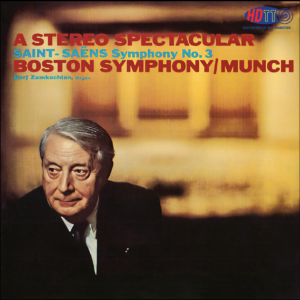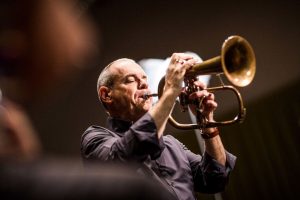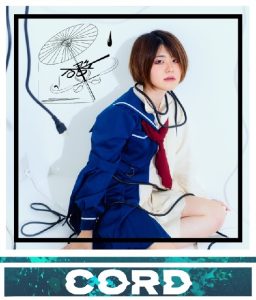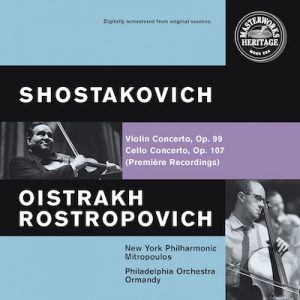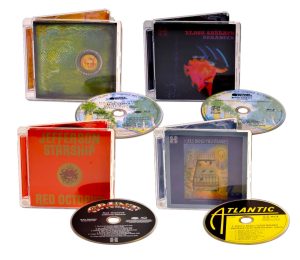There are times when something so special comes along that one needs to shout "Stop the presses. Hold page one." This is one of those occasions. HDTT has just released a superb DSD256 transfer of the legendary RCA Living Stereo recording of the Saint-Saens Symphony No. 3 "Organ Symphony" from Charles Munch and the Boston Symphony Orchestra. And it is a stunning digital transfer.
Saint-Saens Symphony No. 3 "Organ Symphony", Charles Munch, Boston Symphony Orchestra, Berj Zamchochian, organ. HDTT 1959, 2022 (DSD256/DXD) HERE
As one very experienced listener said to me after listening to this release, "This transfer is amazing and gave me chills when I listened to it."
I once had the Classic Records 45rpm vinyl reissue of this album and thought it very special. And then I heard Analog Production's 15ips reel-to-reel release of this album on a friend's system and was stunned by that. I've been ruined by those two wonderful analog reissues for listening to any of the digital reissues I've been able to find over the years. They've all disappointed for one reason or another.
But now I have listened to Bob Witrak's DSD256 transfer from a 15ips tape and I am once again singing "I'm in heaven..."
I have only the CD and the RCA/BMG SACD to compare. I don't have the AP SACD. The RCA/BMG SACD is quite good. If I weren't so doggone picky about instrumental timbre, I could live with it (and have). But it still sounds somewhat compressed and flat by comparison to the DSD256 from HDTT. Can you say "cardboard cutouts?" This is how the instruments on the SACD sound to me by comparison to the HDTT. And then there is the issue of sounding flat and somewhat shrill. The CD? Oh dear, I won't even go there. The AP SACD may be appreciable better, I don't know.
On the other hand, I will tell you that the HDTT DSD256 brings beautiful silky string tone, great timbral depth and texture, and air around the instruments that I don't hear in my other two digital releases. As with some other HDTT releases, the instruments just sound more real.
Also, the HDTT also has greater dynamic range. Be prepared for quiet sections to be very quiet indeed and for orchestral climaxes to rise to the roof. When Ann listened, I saw her diving for the volume controls in a couple of places.
As to provenance, Bob Witrak says that this is a transfer from a 15ips tape. He had several tapes to choose from over the years, but had been holding off until he was satisfied he had one he wanted to transfer for release. This is the one. And it is a beauty, imo.
I had the opportunity to email with Bob about this release to see what he would share about his source. He replied, and I quote with permission:
Honestly, I have had several sources on this title. All were from 15ips tape, but I have held off for a while to release one of them because I wasn't sure which one. Many I heard were not good. I found older releases on 4-track tape to just sound kind of muffled and dead. Same with many of the LPs I used for listening to the performance. So, it took me a while to figure out which tape to transfer.
It is truly a magical recording--it almost has an ethereal quality. It's very difficult not to listen to the whole performance when you listen to it on occasion. It is just highly addictive.
If you have the 45rpm vinyl reissue, or the AP 15ips reel-to-reel, you have excellent releases of this album. If you are a digital listener as I am, or if you are a dual media listener looking for a better reissue, I highly recommend this new release from HDTT. The recording as heard here is just magical.
Now this is just for you sound-junkies out there wondering about more information on what I'm hearing with this release...
Can you say inner detail, micro- and macro-dynamics, deep bass, extended ethereal highs? Pull out all your audiophile descriptive terms. They all apply to this recording, this reissue.
RCA recording engineer Lewis Layton simply nailed the original recording in Symphony Hall. He managed to capture the orchestra in excellent breadth and depth, but he was further able to balance the huge Symphony Hall organ into the mix. We often think of the organ coming into the sound field, in full glorious brilliance and deep resonance, at the beginning of the fourth movement. But, those who have paid attention know that the organ has been an integral partner in this symphony all the way through. The fourth movement is simply where it takes center stage, with full drama. In the earlier movements, it is the foundation just as the double bass. It is regularly present, but providing the gravitas support structure under the strings. If your system is not telling you this, you have some bass reproduction limitations, or some resolution limitations, somewhere.
The first time we hear the organ is as the first Allegro moderato movement fades into the emerging Poco adagio. It follows a series of cello and bass pizzicato that is simply mesmerizing to hear. The organ appears with very low soft, sustained pedal notes, almost not heard below the strings. As the second movement continues, the organ takes on a beautiful dialogue with the strings.
This is all very clearly resolved in this transfer. (By the way, that series of plucked notes in cello and bass mentioned above is very nicely resolved in this transfer, as well.)
The organ bass notes can be very, very deep on sustained pedals. But, most importantly, the sound is clear, clean and well articulated. Not just a muddy mess. As noted by R.D. Darrell in the original liner notes for the album:
The great Symphony Hall organ was designed by C.. Donald Hanison built by the Aeolian-Skinner Company and installed in 1949. The particular registrations employed by Mr. Zamkochian here are, in the symphony's Paco adagio, first the Diapason and Flute stops of the Swell Organ; then the latter's Viole-de-Gamhe and Viole-Celeste stops with the subterranean 32-foot Pedal Coutre Violone; and, in the ending of this movement, the barely audible ethereal tones of the 8-foot Aeolian stop of the Swell Organ. In dramatic contrast, the second half of the second movement calls for the unleashing of the tremendous resources of the full organ, sonically dominated by its Bombarde division, which comprises six ranks of Plein Jeu, 16-foot Bombarde, 8-foot Trompette Harmonique, and 4-foot Clairon Harmonique.
Strings have a lovely delicate tone throughout the recording. The violins are pure and sweet in their upper registers, with nice resonance and bite in the middle range. In the very opening of this symphony, the violins enter first with shimmering vibrato that is wonderfully well presented. Delicate notes from the winds follow, all with a lovely timbre. Then we're off. Cellos and bass are taut, tight, and resonant, with deep growl when called upon. Brass has a deeply burnished glow. Flutes and piccolo enter in refrain, again with just beautifully natural, organic sound. Low, light orchestral drum strikes reverberate over and across the whole. This entire assemblage rises in urgency until at about 4:20 everyone is engaged, rising to a culmination from which they all then recede like a a wave receding from the beach. As I listen yet again, I am struck by the marvelous tympani work in this movement—it is precise, delicately powerful, with excellent rendition of mallets on skins, sometimes so softly struck one can scarcely hear it but still exceptionally clear and resolved on this transfer.
As Bob Witrak says, this symphony has an almost ethereal quality. This performance enhances that feel in spades. And this transfer of the recording captures all of it. If you want a truly magical performance of music in your music library, you need this performance and I don't know of a better digital transfer available.
Recommended most highly.
Would you like a second opinion? I'm only one listener and can only tell you what I hear, so it's nice when we can add a converging opinion from another careful listener. In this case, Rob P. from United Kingdom writes on the HDTT site: Sound-wise the DSD256 is in a different class to the RCA and Analogue Productions SACDs it was compared to, having greater projection and power (the organ and timpani are superb), far richer, more faithful instrumental timbres, which rival the first label Living Stereo LP it was also compared to, better definition and much more space around the instruments. All of which makes this a must have download and the finest remastering I have heard of a Munch Living Stereo album.
Note about the transfer: Bob says this release was edited in DXD PCM from a DSD256 Master then the DXD edited master was used to generate the final DSD files using Merging Technologies Album Publishing.




